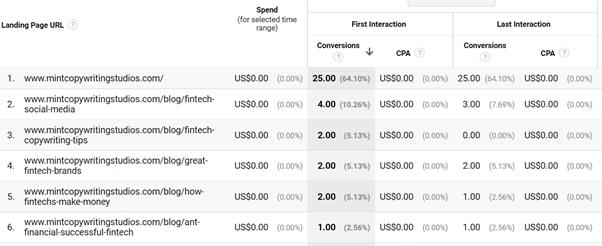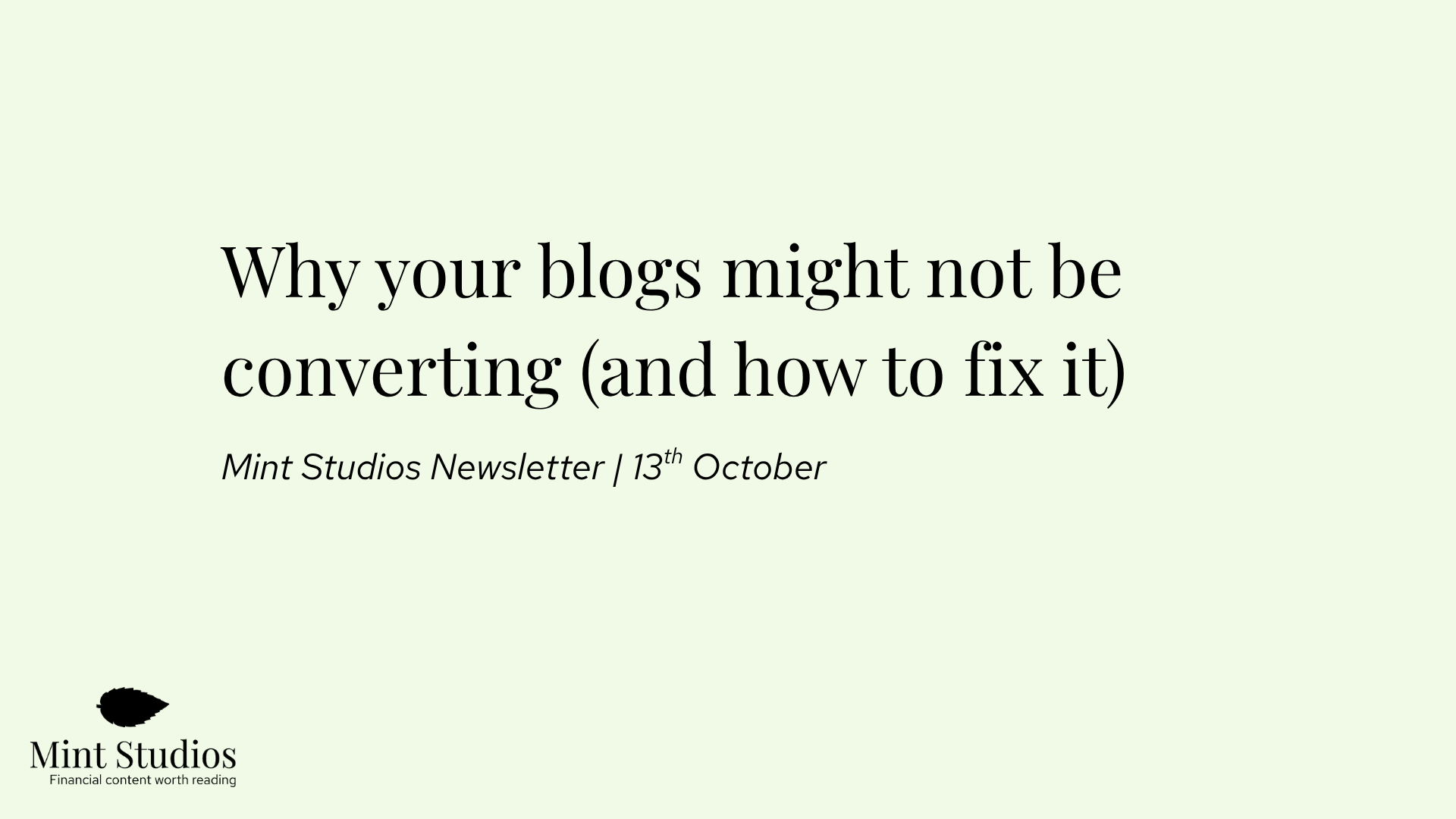You know when you start reading an article and immediately your eyes start glazing over?
When it feels like the article was written to check a box, rather than for someone in particular? When they use big words like “cloud intermediation” and put in random statistics that no one really cares about?
As a writer, I was asked to write those types of articles — and I didn’t like it. I got tired of writing “thought leadership”, “ultimate guides” and white papers that I knew no one would ever read — much less buy a product or service from.
There are a few reasons why this type of content exists — which I get into below — but the fact is: this can be avoided. You can create great content that people read, that people like, and most importantly, that will turn them into customers.
So I decided to set up a financial services content marketing agency that would help address some of the gaps in the content marketing world, and help financial services and fintech companies use their website blogs to acquire customers.
Here’s what I’ll cover in this article:
The gaps in the content marketing and writing space
In an ideal world, every company would have their own content team. With an in-house content writer and strategist, you would be able to make sure the strategist and writer understand your product and niche inside out, talk to the people in your team whenever necessary and be totally aligned with business objectives.
But this is difficult for a few reasons:
- Two full time content people is not cheap. According to a Superpath survey, full-time content marketers make an average of $91,502 per year. That’s because content marketing is an in-demand skill, the niche is very young and requires a unique combination of skills.
- There is a shortage of good content people, which means they are difficult to find. Anyone can write content, but not anyone can write content that drives actual business results. That is a trained skill, which is much rarer.
- It’s a fast evolving and specialist role, so you can’t hire a recent grad/journalist and expect them to do an amazing job. It’s a role that does require a combination of business, marketing, and strategic writing expertise that is always changing.
For these reasons, companies choose to outsource content marketing. When done well, working with freelancers or an agency is a great option and the ROI can be enormous.
But when done poorly, it’s a tremendous waste of time and money. The problem is, it’s very easy to do it poorly. Why? I believe it’s because there are a few gaps in the content marketing world:
Most content strategies don’t focus on conversions
When it comes to content strategy, many people will do something along the lines of:
- Create a list of keywords based on what your competitors are ranking for.
- Sort by highest volume.
- Hire freelance writers to create content that targets high volume, low competition keywords.
I’ve also seen agencies that will simply ask the client to come up with content ideas, and they’ll do the rest. I’ve even seen agencies and freelancers that just guess the topics and make it up.
The problem with all these approaches is that the content is not aligned with business objectives. If you’re picking topics out of thin air or writing content solely based on keyword search volume, you aren’t writing for customers. You’re writing to meet an arbitrary goal e.g. one blog post per week.
Why does this happen? The hard truth is because focusing on conversions is hard. In order to write content that generates customers, you need to base your strategy and content on in-depth customer and client research, an understanding of the competitive landscape as well as the competitive advantages of the product inside out.
It requires discovering pain points, and then creating comprehensive content that targets those pain points. It’s also hard because most people don’t track conversions. Which brings me to my second point.
Most people don’t track conversions
The reasoning behind the “keyword-first” approach is: let’s focus on generating traffic. And sure, traffic is important — but more traffic does not always equal more conversions.
Businesses that invest in content marketing expect to see a return on their investment. But there’s no way of calculating that return if you don’t know how many leads/customers/sales your content is generating.
Now, some people will say that attribution is impossible and you can’t measure how many conversions your content is generating. And sure, it’s not the most accurate science — but there are ways to measure conversions. With Google Analytics and other tools, you can measure how many conversions you’re getting by tracking button clicks, form submissions and other conversion types.
Here’s a screenshot of newsletter conversions I’m getting on the Mint Studios website. With GA’s Model Comparison Tool, I can see how many conversions my various blog posts are generating

From my experience working as a freelancer with around five agencies, none of them tracked conversions. This seems to be a general trend, as other people agree that most businesses are not tracking at all.
Instead, what happens is people focus on vanity metrics such as publishing X amount per month or general pageviews. The problem with this, is that you end up creating content that is generating traffic, but no conversions at all. And so you end up with this type of content:

Sure, people are researching these types of articles and probably find them useful. But are they your target market? Are these people who actually would convert and use your product?
By tracking conversions, you can quickly see which article types are generating business for you. You can also make sure you are aligned with business objectives.
Hiring freelance writers doesn’t work for MANY companies
I’ve written about this before, but I’ll summarise it here again. I have no issue with freelance writers — I used to be one myself — but there is a freelance writing conundrum. From my own experience, content marketing agencies will work with freelance writers or specialist freelance writers.
In my opinion, the freelance writing model doesn’t work for many companies for three reasons:
- Freelance writers usually don’t know about your product (and therefore write Top of the Funnel content that doesn’t drive conversions)
- Specialist writers are usually too expensive for startups (for a good reason)
- Most freelance writers don’t know about strategy (it’s not their job)
I know this because I was one myself. When I was writing thought leadership and the like, I always had a nagging feeling: what is it that my reader really wants to read? Is this what they’re interested in? Where should I mention the client’s product?
As a freelance writer, I didn’t understand my reader’s pain points, and neither did I always understand the product (although I did understand the niche).
If you’re a B2B financial services company with a long sales cycle and contracts of £10,000+ per month, you need to be able to write advanced content that talks about your product. You need to be able to go in-depth, talk about technical matters, include case studies and answer specific questions.
If you work with a freelance writer who knows nothing about the product or is a generalist, you end up with “Ultimate guide to payment processing” and “10 tips to implement your payment gateway” type articles. It’s great for beginners, but will it impress your advanced customers? Probably not.
In regards to the financial services world, generalist writers might create articles based on research on Google, and might not know about regulation and certain topics that need to be mentioned in financial services. When it comes to financial services, it really helps to understand certain nuances and products beforehand.
In order to get customers to convert and be interested in your product, there’s no way around it: your writer needs to understand the niche, your product and your customers. So how do you get around it? See how we approach it at Mint Studios below.
Most people don’t bother with content promotion
Everyone in the content marketing world will tell you how important content distribution is, and how hard it is. Content distribution is incredibly important to help get leads in the door while you’re waiting for SEO to do it’s magic — and posting on social media is not enough.
We’re still figuring out the best way to do this for clients at Mint Studios, as it’s not easy. But we do content promotion and play an active part in it. This is different to most content strategies and efforts, where promotion is not a big part of the mix.
How I’m building a financial services content marketing agency that fills these gaps
Based on my own experience working with content marketing agencies and doing strategy for financial services companies, I decided that the best way to help financial services companies successfully implement content for customer acquisition, was via an agency — not by being a writer, or even a freelance content marketer.
Here are a few ways we help financial services and fintech companies acquire customers with content:
Our strategy is based on in-depth research on your company, product, industry and customers
The benefit of being an agency rather than a freelancer, is that we are a team who can bring additional resources and really work as an extension of your marketing team. That means that we can invest the time and energy into doing in-depth research on your company, product and industry if necessary. We’re very invested from the beginning.
In month one of working with you, we’ll talk to the sales team, customer service, product managers and if possible, customers. This research helps us understand customer pain points and product features in-depth, which then allows us to create a content strategy that is focused on converting readers into customers — rather than just traffic.
We follow pain point SEO and focus on creating Bottom of the Funnel content, rather than “ultimate guides” and “X tips” type articles. We use the Mint Studios framework which allows us to focus on conversions. You can read more here:
Not only that, but having an in-depth understanding of your company and product means that we know when to mention certain product features, or highlight a case study. That’s how we’re able to go so in-depth on certain posts.
Here’s a recent article we did for a client: How To Create an Invoice in Australia.
We would not be able to go into so much detail about our client’s product without having an in-depth understanding of their features.
We track conversions
We’re creating content that is focused on conversions, and we’re also tracking how we’re doing and reporting the results. We use Google Analytics, Google Tag Manager and other tools to help us attribute which articles are generating what conversions.
It’s not a perfect science, but it means you’ll know the ROI of the content we’re producing. We already have the skills in-house and we know how to set up all the conversion tracking on Webflow, Wordpress, Hubspot, you name it. We also know how to set up formatting so your articles are easy to read and optimised for conversions.
We can set it up in under a day and have a quick overview of the health of your website — that’s one of the benefits of working with an experienced agency rather than just a writer.
The content we write is in-house and based on interviews
One of the biggest issues in the content marketing space is the conundrum of working with freelance writers: they might be short-term, they might not know about your product and they might not even know about your niche, which is why they can often only write beginner type articles.
There are two ways we manage to create content that is advanced, includes important details about your product and is focused on conversions:
1. One long term, in-house writer dedicated to your content
Writers in our team are long-term. We don’t hire just for a short period of time or work with freelancers just when we need them. The main benefit of this approach is that you build a relationship with the writer who will in turn understand your product, customer pain points and niche a lot better over time.
2. Content is based on interviews with the team
The content we produce is not based only on researching Google and regurgitating what other people have written. It’s based on interviewing Subject Matter Experts (SMEs) within your company. This helps us solve various problems:
- The content is based on your knowledge, not on the knowledge of the writer. That means we can write advanced and more technical type content.
- We can introduce product features and case studies wherever necessary. By interviewing an SME, we can ask when it makes sense to mention the product. This way, we include everything necessary to write a true BOFU type article:
These are all pieces of content created that are based on interviews:
- How to Open a Sole Trader Bank Account (In Under 10 Minutes!)
- PayTo: How to prepare and plan for it (with use cases and examples!)
- Top payment orchestration platforms (and what to look out for)
We also do content promotion
Content distribution and promotion is a continuously evolving and rapid moving sector. Before, promoting in communities and on social media was enough to get the word out there — now, it’s not enough.
It means we are continuously experimenting with content distribution for clients. Here are a few ways we promote content:
- We partner with a link building agency that helps us build backlinks to our pieces of content. This helps accelerate rankings on Google and therefore help you get leads in the door more quickly.
- We set up introductions to content publications. One great way to distribute content is to leverage the audience of others. So we do research on potential partnerships. For example, with one of our clients — a neobank for freelancers — we set up an introduction with a freelance job board.
- We offer a premium tier where we distribute via Facebook ads. With our higher tier, we will set up a Facebook account and promote blog posts via Facebook ads. This helps get leads in the door right from the beginning.
We’re also experimenting with quoting influencers on pieces and other distribution channels.
We only work with financial services
Many people come to us because we know the financial services niche inside out. Personally, I host the Fintech Marketing Slack group and the Market Like a Fintech podcast. I’ve been in the financial services and fintech space for several years and am very active in the industry.
There are certain things that you need to know about financial services. This includes regulation — what can and can’t be said in a blog post — as well as how certain parts of the financial ecosystem work. We understand Open Banking in-depth, as well as investing, stocks and the rest. That experience means we know how to explain it to others (although we’ll still do the interview with a Subject Matter Expert).
As a content marketing agency, we’re able to actually move the needle for financial services companies a lot more than as a freelancer or writer. Content marketing is not cheap. If you include hiring a specialist writer, a full-time content strategist, doing promotion and all the costs of tools, it can cost upwards of $10,000 per month.
With an agency, we’re able to offer all of this, along with our experience and expertise, for half the price. We have all the experience, we have the expertise, and since we are a team, we are able to deliver quickly and hit the ground running.
With this agency, I’m able to fill the gaps I’ve seen in the content marketing and writing industry, and offer a service that genuinely generates business for financial services companies.
You can read more about how we think about content marketing below:
- Why We Believe Hiring Freelance Writers Doesn't Work For Most Companies
- What Is BOFU (Bottom Of The Funnel) Content And Why Is It Important?
- How To Write A Blog Introduction That Converts
If you’re interested in learning more and working with us, get in touch below:











